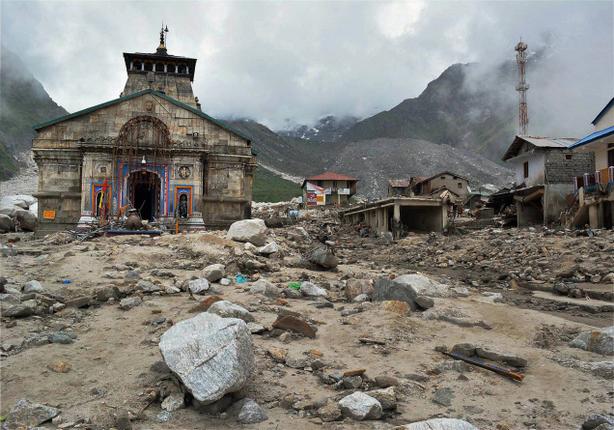Torrent in Lake Caused Extensive Damage at Kedarnath

New Delhi, July 4, 2013: On June 17, after a night of incessant downpour, around 6.15 a.m., Faram Bahadur Bhandari, 38, and his colleague Dhandir Singh, 26, came out of their tents perched high near the Chorabari glacier at 3,820 metres, to check the raingauge at their research station. Staff members of the Wadia Institute of Himalayan Geology (WIHG), Dehradun, which is an autonomous research institute of the Central government’s Department of Science and Technology, both were trained observers of the region.
On June 16, Faram had tried to call his mentor and senior scientist Dr D P Dobhal at WIHG and warn him of the deluge in the Kedarnath region but the phones were not working. Coming out of their tents that morning, the two staffers heard a deafening explosion and saw the water “jumping down” in a cascade of debris and mud from the Chorabari Lake on the side of the glacier into the valley. They thought of running down and warning the hapless residents of the temple town. But it was all over in a flash, says Dr Dobhal. Within a few minutes mountainous debris had washed down taking with it everything in its stride. The water flow was about 20 to 25 metres away from Faram and Singh but they quickly made their way up the steep rocky mass on the other side of the lake and saved their lives. Their tents, equipment, phones, cameras were washed away and all that’s left probably, speculates Dr Dobhal, is the tower of the Automatic Weather Station. The two men spent a night on the rocks trying to find a way back and made it to Kedarnath the next day. They were evacuated only by June 22.
Dr Dobhal, who has been surveying the area since 2003, says Gandhi Sarovar or Chorabari Lake which is located at 3,900 metres is a permanent water body on the side of the Chorabari glacier and has been in existence even in maps of the area from 1962. The glacier is about two km upstream from the Kedarnath temple. The lake is surrounded by hard rock on one side and a lateral moraine on the other. “During my observation of this lake in the last 10 years, I wondered what would happen if the lake filled up. I always kept a close eye on the lake and I never found the level rising much. My team which was there from May 18 to June 5, had got a photo of the water level in May which was not more than 1 to 1.5 metres, covered with fresh snow,” he told The Hindu over the phone.
This event can be termed as a Lake Outburst Flood, says Dr Dobhal, but not a Glacial Lake Outburst Flood (GLOF), a menace in the Himalayan region. He says the lake is fed by snow and not by the waters of the Chorabari glacier which has receded over the years. While the catastrophic events do resemble the destruction caused by GLOFs, Dr Dobhal says the lake was full to the brim and burst its moraine barrier since there was no natural drainage. That outburst is what caused the most damage on June17 and the tons of sediment and water wreaked havoc down the valley. The over 300 mm of rain recorded on June 15 and 16 accelerated the snow melt into the lake. The rain was too early and too heavy causing this extreme event.
“We didn’t anticipate Chorabari Tal would fill up like this and burst. Now we will have to identify the water bodies in the region, map them and keep a constant watch,” he says. The lake is about 20-22 metres deep and at no point in the past was there a threat of overflow. Belatedly, it will have to be kept under watch from now on.
Source: The Hindu, DT. July 4, 2013.







